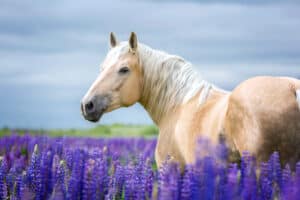- The former also tend to be more robust compared to the latter.
- Ponies’ reputation for being mild-mannered compared to horses does not necessarily hold true, all the time.
To understand the key difference between ponies and horses, you first need to understand how equines are measured. The traditional method used to measure a horse or pony is in hands. One hand is equal to 4 inches. The tradition developed because the average width of a man’s palm is 4 inches.
Horses and ponies are measured from the ground to the highest point of their withers, the rounded area at the base of the neck that connects with the back. A pony is 14.2 hh (hands high) or smaller, while a horse is anything taller than 14.2 hh. So, a pony is any equine 58 inches at the wither or shorter, and a horse is anything taller than that.
While size is the main difference between horses and ponies, there are some other differences you can expect. Ponies typically have thicker, bushier manes and tails. They also grow a heavy, long winter coat. While horses do grow a winter coat, they are not typically as long as that of a pony.
Comparing Ponies vs Horses
| Ponies | Horses | |
|---|---|---|
| Height | 14.2hh or shorter | 14.3hh or taller |
| Conformation | Coarse | Refined |
| Temperament | Generally calm | Varies |
| Dietary Needs | Gain weight easily | Varies |
| Coat | Coarse mane and tail, long winter coat | Fine and smooth |
The Four Key Differences Between Ponies vs Horses
Ponies vs Horses: Size
The most obvious difference between a pony and a horse is the size. Many people assume anything larger than a Shetland Pony or other small breed is a horse, but a pony’s back can be over 4 1/2 feet tall. Large ponies can easily come up to the average adult’s chest.
Ponies vs Horses: Temperament
Ponies, in general, have a more docile nature than horses, but that isn’t always true. One issue with ponies is, due to their smaller size, it can be a challenge to find an adult small enough to train them. Ridden mostly by children, they may develop bad habits.
It’s also worth noting that ponies can be a case of deceiving appearances. Their relative strength and sturdiness notwithstanding, they occasionally love to shirk their duties and can be somewhat crafty – conduct which is at odds with that cute, adorable exterior.
And once their minds are made up, getting them to budge can be an uphill task.
Horses have a range of temperaments as well. Many horses bred for generations to work, such as quarter horses, have a very steady temperament and are a great choice for beginners. Horses who are known to be sensitive and spirited, such as the Arabian, are often referred to as hot-blooded.
Ponies vs Horses: Metabolism
Ponies have a slower metabolism than horses. This means many ponies easily maintain their weight on little food, and foods like rich spring grass or grains can cause weight gain. This can also lead to health problems, such as laminitis, which is a serious metabolic condition that affects the pony’s feet.
Some horses also have slower metabolisms, but most require more feed than ponies. A horse that gains weight easily and doesn’t need much, if any, grain to maintain its weight is known as an easy-keeper. A horse that needs more, higher-quality food to maintain its weight is called a hard-keeper.
Ponies vs Horses: Build
Horses are generally more refined than ponies, with longer legs and necks, and finer bone structure. Among different horse breeds, there is a range of builds, but even stockier riding breeds, such as the quarter horse, are generally more refined than a pony.
Ponies are typically stockier, with sturdy bones and hooves, and chunkier necks with a less-refined head. Many ponies have conformation more similar to draft horse breeds, such as Clydesdales, than riding horses, although they are much smaller.
Up Next…
Keep reading these posts for more incredible information about key animal facts.
- Elk vs Reindeer: In spite of a close resemblance and a shared love of cold weather, they aren’t quite the same. Find out what features differentiate these cervids from each other.
- Guanaco vs Llama: They’re both camelids, but one’s smaller than the other, has finer fur, and is less accustomed to human company. Read about how to tell them apart, right here.
- Stork vs Heron: What Are the Differences? Long legs, a pointed beak, and a fondness for water are a few similarities they share. However, there are a few differences too. And they’ve all been listed here for your reading pleasure.
Thank you for reading! Have some feedback for us? Contact the AZ Animals editorial team.








